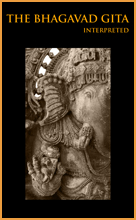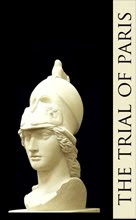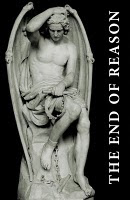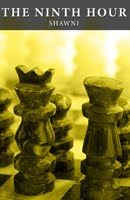An aside: I have hesitated to refer to these different religious cultures as semitic or aryan respectively, only because the use of such terms is bound to concepts of racial “purity” and cultural “superiority” which have no real substance or support. I certainly do not subscribe to the belief, on one side, of a “master race” nor on the other to the notion of a “chosen people.” Such ideas of racial superiority are flatly wrong; they are repugnant and deserve our contempt. I refer to semitic faith or aryan faith only in terms of cultural, linguistic and geographical differences, not in terms of racial differences, which exist primarily in the imaginations of lunatics and imbeciles.
Because Rama, Krishna, and the Buddha emerge from the fog of history at different times and in different circumstances, I plan to treat each of them independently of one another. In other words, the work will be broken, like the End of Reason, into three parts. The first part will deal with Rama, the second with Krishna, and the third with the Buddha. I also plan to use this organization to build arguments about the meaning of exclusively Indo-aryan concepts of moksha, karma, nirvana, et al. But I will do so chronologically. Thus, the section on Rama will not touch upon Krishna or the Buddha. The section on Krishna may touch upon Rama as a point of reference, but not upon the Buddha. And finally the section on the Buddha may make reference to Krishna and Rama as a means of tying up the loose ends of these religious traditions; to bind them more closely together while acknowledging the unique lives and missions of these messengers of God. I do this partly for convenience, partly for narrative structure, and partly because I believe that individually they did not have a universal message for all mankind, but had specific missions in their times and places. While many of the truths that they espouse are universal, their missions were nevertheless focused on the times and places in which they lived.
Much the same can be said of Moses, Jesus and Muhammad. For example, Moses betrayed no wish to convert the people of Egypt to the Hebrew faith; Jesus was clear that his mission was to gather the lost sheep of Israel; and Muhammad taught a broad tolerance for other faiths, despite the reality that Islam had superseded all prior religious revelation. Of these three, Muhammad clearly anticipates universality of faith, but he is, not coincidentally, more recent than Moses, Jesus, Rama, Krishna, or the Buddha. Moreover, Muhammad’s mission was to the descendents of Ishmael, who had fallen into idolatry and infanticide and who would not have responded at all to discussions of moksha or the symbolic possibilities underlying belief in reincarnation. These were not issues among the Arabs. If Muhammad had a message for believers in Indo-aryan faiths, he certainly would have delivered one. So, one can either believe that Muhammad had a universal message that inadvertently omits any reference to the religious faiths of more than half the rest of the world, or one can believe that Muhammad was simply unaware of such faiths and thus the oversight was God’s, or one can acknowledge that Muhammad’s mission was to believers in the semitic faiths (i.e, that his message, while filled with universal truths was local in intention and application). In fact, converting huge swaths of humanity was no more on Muhammad’s mind than it was on Moses’.
This would all seem to argue against my attempt to reconcile varying religious traditions, particularly the semitic faiths with the Indo-aryan faiths. But I am not arguing that Islam, Judaism, and Christianity lack the possibility of being universal in application. Certainly it is possible, though not necessarily desirable. But, to take Islam as an example, successful conversion of Indo-aryan believers can only take place with the application of a universal outlook on religious belief. Sufis had such an outlook and their message had a greater impact in the Indian subcontinent than all the armies of Aurangzeb.
 Actually, Aurangzeb is on my mind for a particular reason. The first part of Breaking the Wheel will be the conversation between Aurangzeb and a priest at a temple devoted to Hanuman. Much like The Men Who Have the Elephant, the third and final part of The End of Reason, Aurangzeb’s determination to destroy this temple will be the cause of the conversation, as a Brahmin priest attempts to explain to the emperor the essential compatibility of their beliefs, despite the apparent differences in doctrine, dogma and practice. Because this is a temple devoted to Hanuman, a key player in the Sanskrit epic the Ramayana, the focus will be on Rama and his position as a messenger of God. Here the first part of Breaking the Wheel begins. The title of this first part is, tentatively, The Temple of Hanuman.
Actually, Aurangzeb is on my mind for a particular reason. The first part of Breaking the Wheel will be the conversation between Aurangzeb and a priest at a temple devoted to Hanuman. Much like The Men Who Have the Elephant, the third and final part of The End of Reason, Aurangzeb’s determination to destroy this temple will be the cause of the conversation, as a Brahmin priest attempts to explain to the emperor the essential compatibility of their beliefs, despite the apparent differences in doctrine, dogma and practice. Because this is a temple devoted to Hanuman, a key player in the Sanskrit epic the Ramayana, the focus will be on Rama and his position as a messenger of God. Here the first part of Breaking the Wheel begins. The title of this first part is, tentatively, The Temple of Hanuman.Aurangzeb would surely put me to death for even imagining such a conversation and I hope that he will forgive my use of him as a literary device. In any case, it is good that the tyranny of one man, like his ignorance, lasts only a little while.






No comments:
Post a Comment